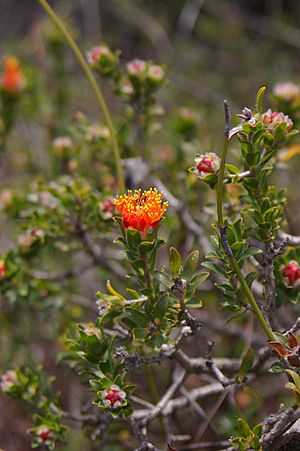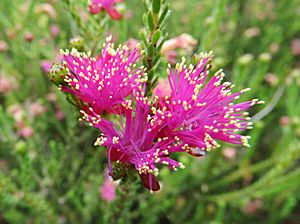Eremaea (plant) facts for kids
Quick facts for kids Eremaea |
|
|---|---|
 |
|
| Eremaea asterocarpa | |
| Scientific classification |
|
| Kingdom: | Plantae |
| Clade: | Tracheophytes |
| Clade: | Angiosperms |
| Clade: | Eudicots |
| Clade: | Rosids |
| Order: | Myrtales |
| Family: | Myrtaceae |
| Subfamily: | Myrtoideae |
| Tribe: | Melaleuceae |
| Genus: | Eremaea Lindl. |
| Synonyms | |
|
Eremaeopsis Kuntze |
|
Eremaea is a group of shrubs and small trees. They are part of the Myrtaceae family, which also includes eucalyptus trees. These plants grow only in the southwest part of Western Australia.
For a long time, not much was known about Eremaea. Then, in 1993, a scientist named Roger Hnatiuk studied them closely. He published his findings, which helped us understand these plants much better. The first Eremaea species was found in 1837. By 1964, 12 species were known. Today, scientists recognize 16 different species of Eremaea.
Contents
What Eremaea Plants Look Like
Eremaea plants are usually shrubs or small trees. They have small leaves that grow one after another along the stem. These leaves have tiny oil glands, which you might see as dots.
The flowers of Eremaea plants have both male and female parts. They grow alone or in small groups of two or three at the ends of the branches. Each flower has 5 sepals (small leaf-like parts under the petals) and 5 petals. The petals fall off as the flower gets older.
Inside the flower, there are many stamens (the parts that produce pollen). These stamens are longer than the petals and often grow in groups of five. The stamens are what give the flowers their bright colors, which can be pink, deep pink, orange, or even violet.
After the flower, a woody capsule forms. This capsule is the fruit, and it holds one to six small seeds inside.
Naming and Plant Family
The group of plants called Eremaea was first officially named in 1839 by John Lindley. He wrote about them in a book called A Sketch of the Vegetation of the Swan River Colony. He noted that there were three species, and he thought E. fimbriata was the prettiest.
Eremaea plants are closely related to other plant groups like Melaleuca, Beaufortia, and Regelia. They are all part of the same plant family. The main differences between these groups are how their anthers (the part of the stamen that holds pollen) are attached and how they open to release pollen.
Eremaea is most similar to Regelia and Calothamnus. These groups have anthers that open with slits or small holes. You can tell Eremaea apart from Regelia by how many flowers are in a cluster: Regelia has many flowers packed together, while Eremaea has flowers that are single or in groups of two or three. Calothamnus plants usually have longer leaves than both Eremaea and Regelia.
In 2014, some scientists suggested that many of these related plant groups, including Eremaea, should all be moved into the Melaleuca group. They made this suggestion based on DNA evidence.
The name Eremaea comes from an old Greek word, eremaios, which means "solitary" or "alone". This name refers to the fact that the flowers often grow alone or in small, few-flowered clusters at the ends of the branches.
Where Eremaea Grows
Most of the 16 Eremaea species are found only in the South West Botanical Province of Western Australia. This area is known for its unique plants. Eremaea plants are an important part of the shrub layer in these regions. One species, Eremaea pauciflora, also grows in a different area called the Eremaean province.
How Eremaea Survives Fire
Eremaea plants have special ways to recover after a bushfire. When a plant is killed by fire, its fruits open and release their seeds. These seeds then grow into new plants. This is called reseeding.
Some Eremaea species also have a special woody swelling at their base called a lignotuber. This lignotuber is underground and can survive fires. After a fire, well-established plants can sprout new growth from this lignotuber.
Protecting Eremaea Plants
While some Eremaea species are common, others are quite rare. For example, Eremaea violacea subsp. Dobaderry Swamp is listed as "Priority One" by the Western Australian Government's Department of Parks and Wildlife. This means it is known from only a few places, and those places might be at risk. So far, no Eremaea species has been declared officially "rare" by the government.
Growing Eremaea in Gardens
People have tried growing some Eremaea species in gardens, but with different levels of success. Eremaea beaufortioides has grown well in sunny spots with good drainage. It becomes a strong, spreading shrub. Some gardeners have even successfully grafted it onto another plant called Kunzea ambigua.
Some Eremaea species grow well in Kings Park (a famous botanic garden), but they are not often seen in gardens in other parts of Australia. Their bright orange flowers, which are not common among Australian native plants, and the way their flowers grow at the ends of branches make them beautiful plants for a garden.
List of Eremaea Species
Here is a list of the Eremaea species that scientists recognize, based on the work of Roger Hnatiuk and the Western Australian Herbarium:
- Eremaea acutifolia F.Muell. – rusty eremaea
- Eremaea asterocarpa Hnatiuk
- Eremaea atala Hnatiuk
- Eremaea beaufortioides Benth.
- Eremaea blackwelliana Hnatiuk
- Eremaea brevifolia (Benth.) Domin
- Eremaea × codonocarpa Hnatiuk
- Eremaea dendroidea Hnatiuk
- Eremaea ebracteata F.Muell.
- Eremaea ectadioclada Hnatiuk
- Eremaea fimbriata Lindl.
- Eremaea hadra Hnatiuk
- Eremaea pauciflora (Endl.) Druce
- Eremaea × phoenicea Hnatiuk
- Eremaea purpurea C.A.Gardner
- Eremaea violacea F.Muell. – violet eremaea
See also
 In Spanish: Eremaea para niños
In Spanish: Eremaea para niños


